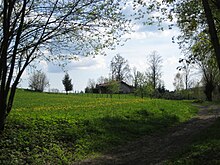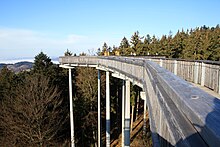Bavarian Forest Nature Park
|
Bavarian Forest Nature Park
|
||
|
Location of the nature park in Germany |
||
| location | Bavarian forest | |
| surface | 2783 km² | |
| Identifier | NP-00012 | |
| Geographical location | 48 ° 54 ' N , 13 ° 9' E | |
|
|
||
| Setup date | 1967 | |
| administration | Bavarian Forest Nature Park eV, Zwiesel | |
The Bavarian Forest Nature Park covers an area north of the Danube to the border ridge to the Czech Republic . The supporting organization is the Bavarian Forest Nature Park e. V. based in Zwiesel . It has existed since 1967, making it one of the oldest nature parks in Bavaria. It is not to be confused with the Bavarian Forest National Park .
location
The Bavarian Forest Nature Park is located in the southeast of the Federal Republic of Germany between the Danube and the highlands of the Bavarian Forest along the Bavarian-Bohemian border. The Bavarian Forest National Park borders in the east and the Upper Bavarian Forest Nature Park in the north . The neighbors on the Czech side are the Šumava Protected Landscape Area and the Šumava National Park. In the southeast, the nature park area touches the Austrian Mühlviertel .



Natural space
The landscape of the Bavarian Forest Nature Park begins on the Danube at around 320 m above sea level. There are still remnants of alluvial forest and structurally rich oxbow lakes . The Lallinger Winkel is known for the cultivation of orchards. On the Vorwaldkamm of the Bavarian Forest, the so-called Danube Mountains, as in the high areas of the Inner Bavarian Forest, the last specimens of the endangered capercaillie have survived.
The pile is an ecologically very rich rock formation . It stretches in a south-easterly direction over a length of approx. 140 km from the neighboring Upper Palatinate to Upper Austria . The more weather-resistant quartz rock towers above the neighboring gneisses by a few meters and provides a habitat for numerous heat-loving animal and plant species. In the interior of the Bavarian Forest there are still structured mixed mountain forests and the typical high-altitude spruce forests with raised bogs and pits , the last relics of forest pasture management.
The Bavarian Forest is one of the largest closed forest areas in Central Europe and, together with the neighboring Bohemian Forest, is of paramount importance in nature and landscape protection. The partially natural forests in the border region and the attractive, historically grown cultural landscape make the Bavarian Forest Nature Park an important part of the protection concept for large landscapes.
Numerous animal and plant species, which have become very rare in the rest of Bavaria and in the Federal Republic of Germany or are threatened with extinction, find their final retreats here.
Otters and lynx are still or again at home here. The sandpiper , a bird species threatened with extinction nationwide, has its largest occurrence outside the Alps here. Other, otherwise extremely rare and endangered species such as kingfisher and dipper make good populations. The river pearl mussel , which was once common, can also be found in a few streams in the nature park area. A total of 18 out of 19 bat species found in Bavaria live in the nature park area. The tunnel system of the Silberberg near Bodenmais forms the largest bat winter roost in Central Europe, including several hundred specimens of the pug bat . In the primeval forest area of the Arberseewand there are still many rare bird species that are dependent on near-natural forests rich in dead wood, such as the three-toed woodpecker . The peregrine falcon has also spread more and more in recent years.
The rare Hungarian gentian is a characteristic species of the mountain meadows of the Upper Bavarian Forest . A number of rare orchid species still grow on the littered and poor meadows of the nature park area, including those that are endangered such as the elder orchid . The arnica , an increasingly rare medicinal plant, has one of its last main areas of distribution here. The Arber region is home to some other special features. The approximately two hectare swing lawn with typical bog vegetation on the west bank of the Ice Age Great Arbersee consists of a dense network of roots about one to two meters thick. At 1,456 m, the Great Arber is the highest mountain in the Bavarian-Bohemian low mountain range. It is the only one to reach the naturally forest-free, subalpine zone. That is why there are also many Ice Age relic species; Birds like the alpine brown-haired and plants like the rock ostrich or the curly fur fern are only found there outside the Alps.
The course of the river Ilz is one of the last wild river landscapes in the Federal Republic of Germany. That is why it was proclaimed River Landscape of the Year in 2002/2003.
organization
The nature park is sponsored by an association recognized as a non-profit organization. In addition to the four districts of Regen , Freyung-Grafenau , Straubing-Bogen and Deggendorf and 89 municipalities, around 70 associations and clubs and around 270 private individuals are members. It works on the basis of the association's statutes, the Bavarian nature reserve guidelines and the nature reserve regulation.
Areas of responsibility
Protection of nature and care of the landscape
Numerous measures are being implemented to protect rare and endangered species or species that are characteristic of the region, some of them also across borders together with the Czech neighbors. The Bavarian Forest Nature Park e. In this context, V. carried out the first lynx telemetry project in Germany. A total of five mobile temporary exhibitions provide information about the various species protection projects. The implementation of landscape plans is professionally supervised and promoted.
Creation of recreational and adventure opportunities
An extensive network of hiking trails with around 7,000 km of marked hiking trails serves those seeking relaxation. Around 1,100 km of this are cross-border long-distance hiking trails, some with luggage transport. In addition, there are around 3,000 km of bike tour suggestions. There are nature discovery trails in around 30 communities, which, together with 13 information pavilions and around 300 overview hiking maps in the area, provide information to those looking for relaxation.
Environmental education and public relations
Several thousand participants are reached as part of the annual annual education program and school class support. A rich, own written and media material provides information about the special sub-areas. Nature and landscape guides act as multipliers.
Support for regional development
Using and providing information about regionally produced products and services is intended to strengthen the region's economic power and increase added value. The nature park strives to contribute to the preservation of a rural, small-scale cultural landscape that has grown over centuries.
Information centers
Another contribution to education and public relations is the cross-border built information center border station in Bayerisch Eisenstein . There is a trilingual exhibition about the neighboring large protected areas in the region.
The post information point in Viechtach provides more information about the unique geological phenomenon of the quartz pile.
The nature park information point in the Würzingerhaus in Ausernzell provides information about the nature park work in general and about the nutrient-poor pine forests on Forchenhügel with their special vegetation.
Information on the Danube, Danube rim break and the Bogenberg is available at the information point in Bogen train station . The exhibition, which opened in 2006, focuses on geology as well as flora and fauna. In addition, the landscape of the nature park area from the Danube to the border ridge of the Bavarian-Bohemian border mountains and the differences to the neighboring national park are briefly presented.
With the opening of the Ilz information point in Fürsteneck Castle in October 2008, the nature park achieved its goal of having at least one information point in each of the four member districts.
In February 2002 a separate nature park information house was created on the southern outskirts of Zwiesel. The optimized timber frame construction with special windows was mainly built with building materials from the region. With the optimal use of insulation materials, windows and components, the building can only be heated by solar energy all year round. A 110 m² thermal solar collector and a large storage tank in the building filled with approx. 21,000 liters of water make a decisive contribution to this . A geothermal collector installed in the ground upstream of the ventilation system also reduces energy consumption.
A 10 kWp photovoltaic system on the roof of the building generates more than half of the electricity required. Other measures such as daylight control and presence switching and the selection of lighting fixtures help to minimize power consumption. The entire building has been ecobalanced as part of a research project and optimized for recyclability, from the building materials to the furnishings. In addition to a visitor counter, there is information about building services, a permanent exhibition about the Bavarian Forest Nature Park and a lecture and media room. The office of the Bavarian Forest Nature Park is located on the upper floor of the building. V. and next to a small library there is also a room for special exhibitions.




